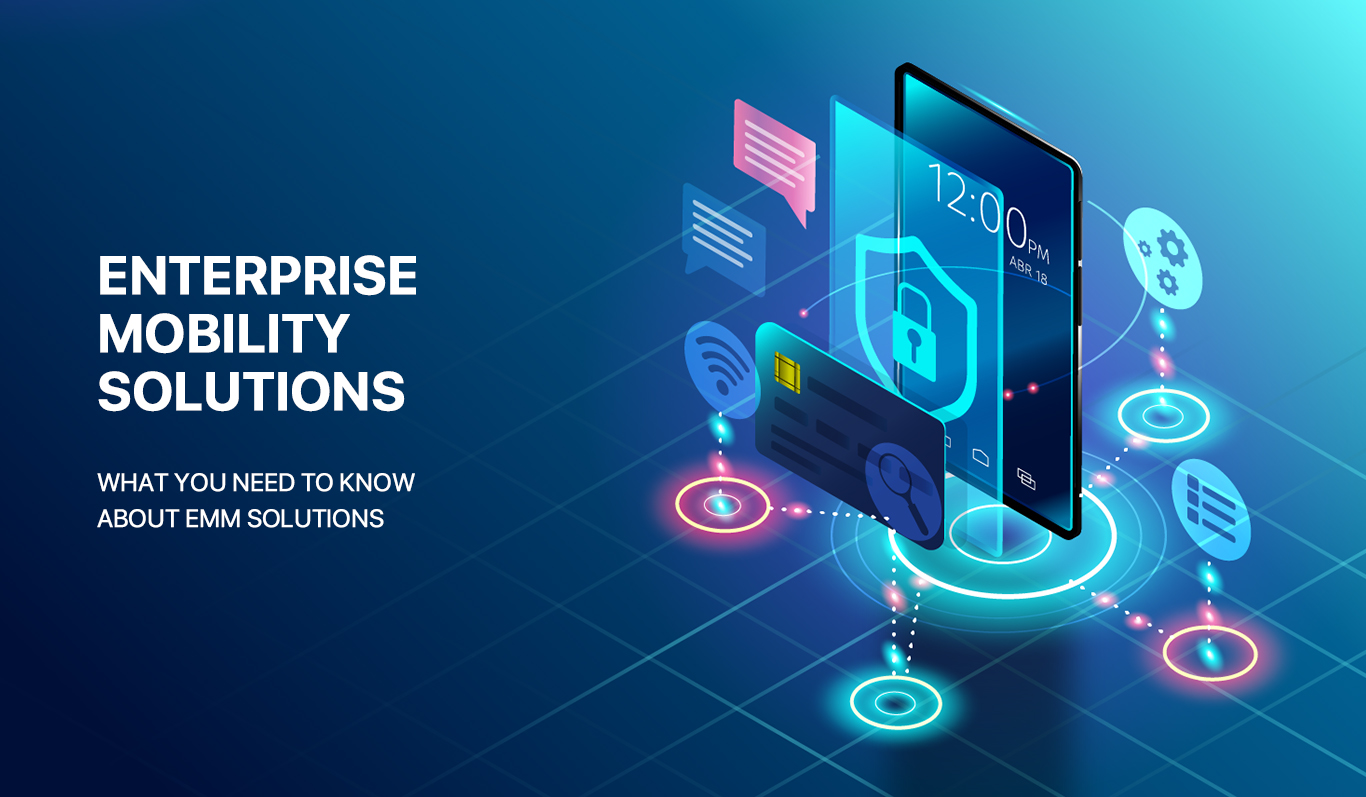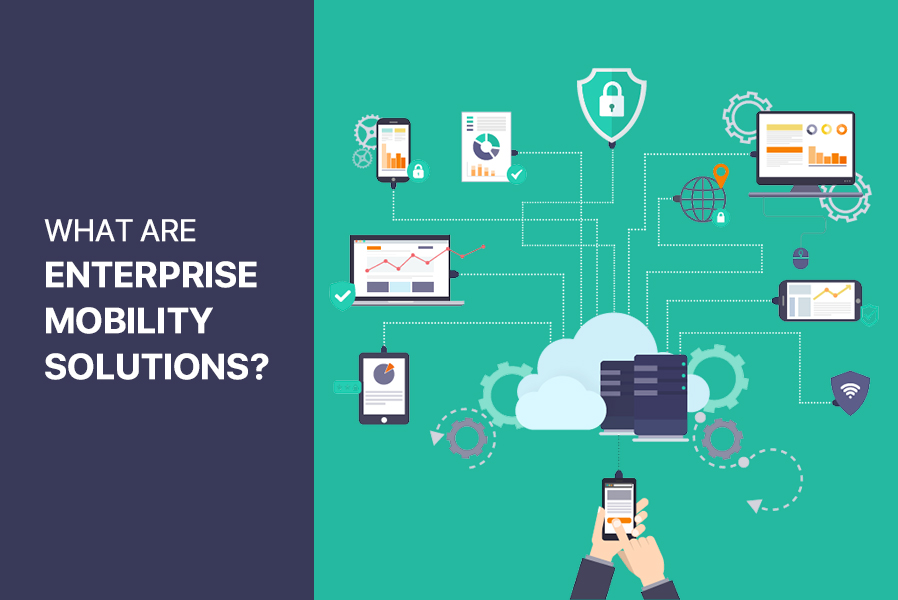A Guide to Enterprise Mobility Solutions – What You Need to Know About EMM Solutions

The mobile world we live in makes enterprise mobility solutions more important to modern companies. In the past few years, smartphones have become so commonplace that employers and employees alike have benefited from their flexibility.
Several people's work and social lives were changed as a result of the pandemic. For the foreseeable future, mobile apps that provide mobility solutions and remote work will drive the enterprise mobility trend.
Business enterprises are looking to utilize and exploit the flexibility and power of mobile solutions by developing enterprise mobile apps. In this article, let us have a look at what enterprise mobility solutions are and how they've evolved over time. Also, we'll explore how enterprise mobility solutions benefit organizations.
What are Enterprise Mobility Solutions?

Over the years, enterprise mobility solutions have evolved quite a bit, making them difficult to define clearly. The first smartphones, as we know them today, started as 'Blackberry's. However, it was not until the introduction of the iPhone that mobile devices became as powerful and capable as they are now.
Every person now possesses a smartphone, typically an Android or iOS device, that contains more computing power than a desktop computer. By doing this, employees had more flexibility and were able to access their work and data from anywhere. As a result of this flexibility and agility, security issues also emerged.
Businesses adopted an enterprise mobility management strategy to secure their operations. Mobile management systems and services are commonly used in enterprise mobility management to protect corporate data, intellectual property, and more.
It is certainly important to include enterprise mobility management systems and services in the discussion of enterprise mobility solutions. There are more security concerns associated with enterprise mobility solutions than just mobile security.
Today, when the terms enterprise mobility solutions or enterprise mobility management are used, they are not limited to mobility services. A laptop or other smart device, such as a tablet, is also included. Additionally, it includes planning and creating UI/UX app designs to engage and motivate employees.
A business mobility solution can be defined as a set of systems and services that provide employees with secure access to information and processes at their organizations and enable employers to design productive, engaging user experiences.
An enterprise mobility solution can cover a wide range of functions. But it is also essential to ensure mobile access for employees, and to expand their ability to access information through modern technology.
Read More.. How to outsource app development.
What Is the Importance of EMM Solutions?
Enhance Employee Productivity
- Flexible work schedules allow employees to maintain a better balance between their personal and professional lives. And with the help of enterprise mobility, they are able to do just that.
- With an EMS, employees can work from anywhere without restrictions. It will be easy for them to accomplish this while still meeting deadlines thanks to enterprise mobility.
- Business data can be accessed by employees anywhere, anytime, and from any device. By allowing employees the flexibility they need to work, organizations can increase their productivity without compromising employee satisfaction and data security.
- Employees can manage approvals, progress updates, timesheet report submission, and other core activities instantly. This consequently increases and improves productivity and helps to keep things moving rapidly without any interruptions.
- When travel is avoided, employees have more time to focus on productive activities.
Reduce Operational Cost
- When your company spends heavily on its infrastructure and maintenance, or you are unable to find a way to reduce it, then you should implement enterprise mobility.
- As your employees will be able to work remotely, EMS will reduce your infrastructure costs significantly. On-site employees can access shared workspaces whenever they need them.
- With an Enterprise Mobility Solutions, you can collaborate across multiple devices and reduce costs at the same time.
- Data can be accessed quicker and safely through EMS, allowing employees easy access to important data.
- Data storage and retrieval are automated and access to the whole system is controlled, reducing time and costs.
Enhance Customer Satisfaction
- Every business places a high priority on customer satisfaction. By using a mobile application, businesses can instantly communicate with their customers, address customer grievances, promote offers, etc.
- Customers will have a greater sense of trust in an enterprise when they can get quick customer support in a short time period. Brands with better customer service are more likely to be trusted.
- There are three key factors that make EMS unique: speed, agility, and customization. Customer service and an intuitive user interface make EMS a valuable tool for improving end-user satisfaction.
- Aside from delivering effective and timely service, EMS encourages customer delight through seamless and smart service execution, creating long-term customer relationships.
Improved Data Security
- Secure data transfer is one of the key aspects of EMS. A comprehensive risk management and data security solution is offered by EMS for your business.
- The use of Mobile Device Management (MDM), Identity and Access Management (IAM), and Mobile Application Management (MAM) can facilitate secure communication.
- It prevents data breaches by permitting only authorized personnel access to corporate data centers.
- Monitoring does not stop with unauthorized access from known or unknown devices. The technology also prevents malware from infecting devices and networks, hence maintaining the security and safety of the entire ecosystem.
What Are the Different Types of EMM Solutions?

In the last few years, enterprise mobility management solutions have evolved to encompass various topics. Businesses may find specific types of enterprise mobility management beneficial, while others may not.
The basic enterprise mobility solutions that you will find beneficial to your business:
- Device management
- App management
- Content management
- Identity management
- Information management
- Expense management
Although some of these different solutions may overlap, it's best to examine them individually for better clarity. The majority, if not all, of these key factors, will need to be considered in an enterprise mobile app development strategy.
Mobile Device Management (MDM)
Almost every aspect of our daily lives is impacted by mobile devices. Employees often use personal smartphones, tablets, and laptops to do their work along with IoT devices in many organizations. While these devices allow employees to work anywhere in the world at any time, they also pose security risks.
In order to manage smartphone and tablet devices, profiles are typically installed that enable remote control, data encryption, and security standards to be enforced. Corporate information could be compromised if a device is lost or stolen. If device management solutions are used in this scenario, all data and apps can be wiped off of a device.
Mobile device management solutions also provide insight into how your employees are using their devices, how they are provisioned, the operating system status, and more.
Mobile App Management (MAM)
Increasingly more employees are bringing their own mobile devices to work, resulting in a rise in this approach to enterprise mobility management. Rather than managing hardware, mobile app management allows organizations to manage software. It is possible to remotely update the app, send push support, and manage licenses once it is installed on an employee's mobile device or computer.
An organization can also control the security of mobile apps using this approach to enterprise mobility. A controlling organization can delete an app and its associated data from the phone when it gets lost or stolen, for example. The same is true when you have employees who are no longer working for the organization.
Employees who are going to be using their own mobile devices for work are less likely to be monitored by enterprise mobility management systems if they are using their own devices. Moreover, it ensures high security. You must, however, ensure that your application is cross-platform because you are unlikely to have the same types of devices for all your employees.
Mobile Content Management
A similar approach to information management is mobile content management. As opposed to database access, content management focuses on content access. The main concerns of content management are:
- Content access
- Content push
- Content security
Typically, content management solutions enable organizations to enforce their own authentication policies. As with application and device management services, content management can also be included. The use of a content management system alone may be effective for some organizations, however.
Identity Management
Enterprise mobility management encompasses a variety of identity management approaches. These include:
- App code signatures
- Device certificates
- Authentication
- Single sign-on
By using this approach, corporate data, applications, and processes will only be accessible to authorized users and devices. The purpose of identity management is to create departmental credentials that ensure all team members have access to the same information and applications.
Information Management
As the focus of these services is remote databases, information management tends to be a part of device and app management. When your organization relies on cloud-based database tools, this is an important issue to consider.
In any situation where more than one device is accessing a database, you should consider how to ensure your information is not compromised. The good news is that we have a lot of great tools available to help us with this problem, and there are already mobility solutions that take care of it.
Conclusion
A variety of enterprise mobility solutions are available to help employees become more mobile while protecting the organization's processes and data.
Finding the right enterprise mobility solution can sometimes feel like a real challenge when the topic of enterprise mobility solutions is so broad. Contact an app development partner like Neetable for help finding or designing a mobility solution that meets all of your needs. As a result of our industry experience and technical expertise, we can guide you and give you sound advice.
FAQs
Why is enterprise mobility important?
The main benefit of enterprise mobility is that it gives employees a range of choices and flexibility, improving their job satisfaction and productivity.
What are the three main types of enterprise mobility management?
The three main types of EMMS are: —
- Mobile Device Management (MDM),
- Mobile Application Management (MAM), and
- Mobile Content Management (MCM).
Why do we need EMM solutions?
EMM contributes to a scalable, secure, and enterprise-ready architecture that is user-centric. To increase productivity, Reduce operational cost, Enhance customer satisfaction, and Enhance data security
Request a Quote
Categories
Popular posts
Best Practices for Software Product Engineering Every CTO Should Implement
2023-14-18How to Build Your Own On-Demand Carpooling App Services?
2023-08-25How to Start an On-Demand Fuel Delivery Business: A Comprehensive Guide
2023-07-28Empowering Miners: How Fleet Management Apps are Transforming the Mining Industry?
2023-07-21A Complete Guide to Develop a Food Delivery App for Restaurants in 2023
2023-07-08Mobile Apps Transforming the Travel Industry: A Game-Changer in Travel Planning and Experience
2023-07-07
